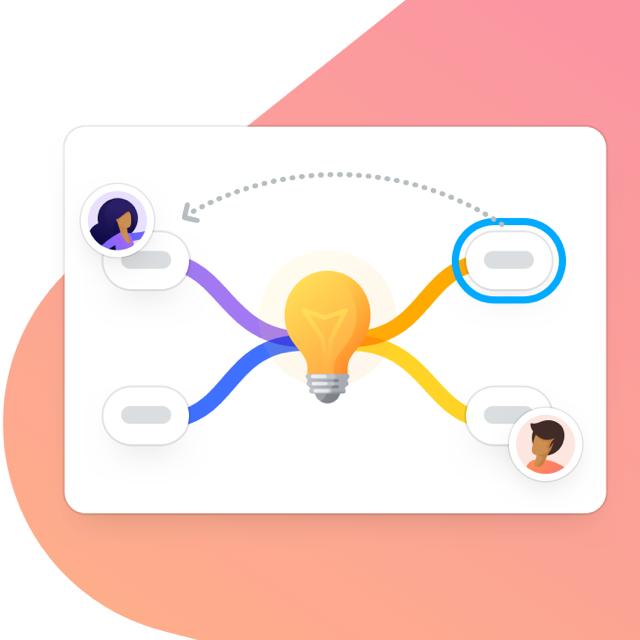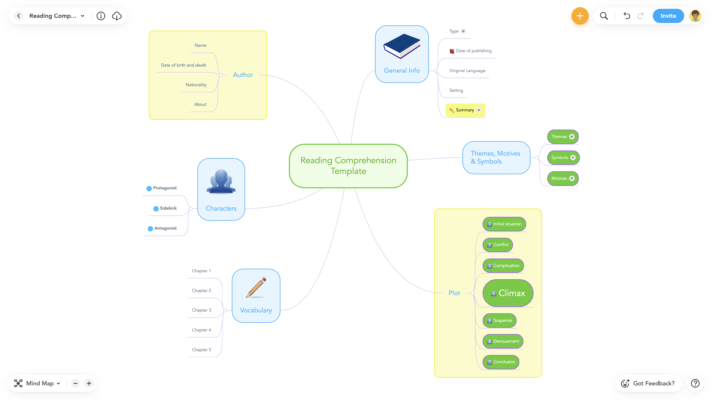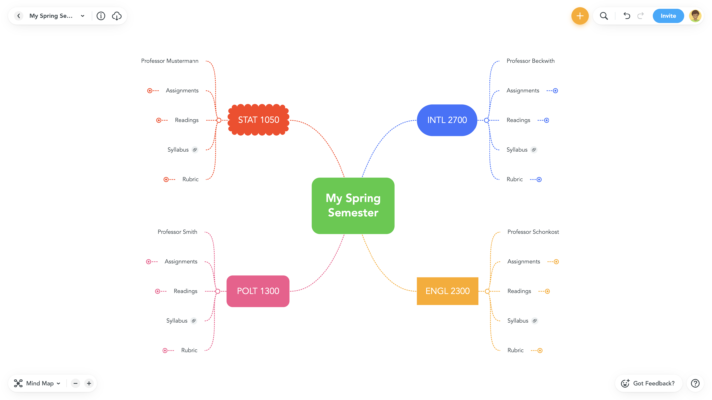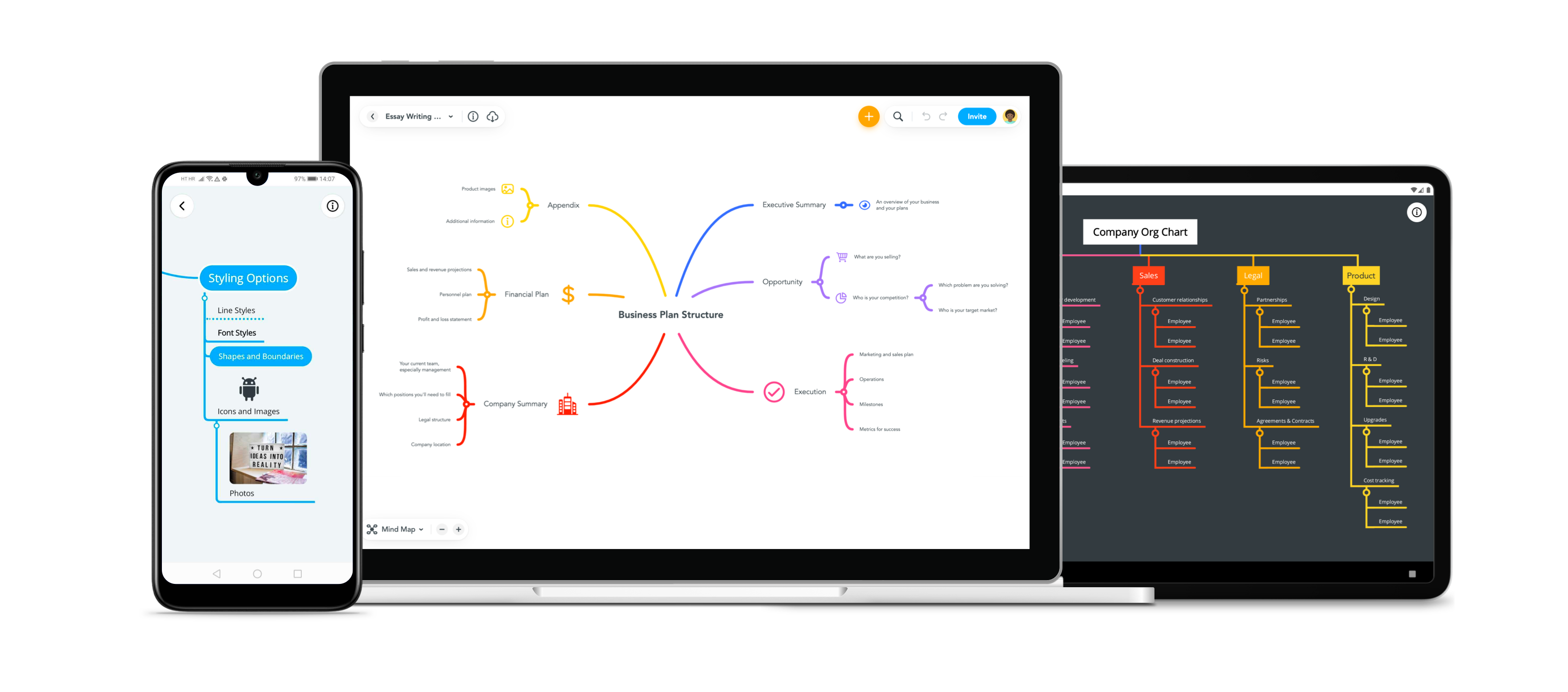As a student, knowing how to use mind maps can almost feel like cheating. Once you’ve learned how to create mind maps, you’ll be amazed at how much faster you’ll memorize information and how easy it can be to write essays, create engaging presentations and more!

To help you start mind mapping quickly, we’ve put together this comprehensive guide to mind mapping for students, including definitions, techniques, tools and 15 mind map examples for students (with templates you can download and use for free).
Table of Contents:
- What Is a Mind Map?
- Why Is Mind Mapping Helpful for Students?
- Mind Mapping Techniques
- 15 Mind Map Examples for Students
If you’re a teacher looking for mind map lesson plans and activities for your students, check out our guide to mind mapping for teachers.
What Is a Mind Map for Students?
A mind map is a diagram that displays information visually, providing a structured way to capture and organize ideas. Mind maps are radial, meaning they start at the center and grow outward. To create a mind map, add a single topic to the center of your map. With the main idea at the center, it’s easy to see and understand the purpose of the map. From the main idea, add related ideas and keywords as new topic bubbles.
Why Is Mind Mapping Helpful for Students?
Mind maps are perfect for students because they are easy and fun to create. If you feel uninspired by traditional note-taking, mind mapping may be perfect for you. Adding colorful elements and doodling is highly encouraged — the more you individualize your map, the better. The idea is to simply make it as memorable as possible. And, compared to traditional linear notes, studying using flashcards or brainstorming with bullet points and outlines, mind maps have several advantages. Here are just a few:
- A mind map’s radial structure directly corresponds to the way our brains store and retrieve information.
- A mind map conveys hierarchy and relationships between individual ideas, enabling you to see the big picture.
- A mind map makes use of mental triggers (such as pictures, colors and connections) to help your brain memorize things more easily.
- The best part — mind mapping doesn’t feel like work!
Anyone can create mind maps. Whether you’re a postgraduate student or just starting your academic career, mind maps can help you structure, manage and memorize the knowledge you’re trying to acquire.
Mind Mapping Techniques for Students
If you’re not sure how to start creating mind maps, check out our Mind Mapping 101 course. It will walk you through the exact process you need to follow to create mind maps for homework assignments, note-taking, group work, studying and more.
Once you have the basic process down, you can create your first mind map. To get started, you’ll need a writing utensil and a piece of paper. If you want something more flexible and fun, try an online mind mapping tool. With a web-based tool, you have the ability to customize your mind map to meet your specific needs and access it from anywhere at any time.
A tool like MindMeister lets you create flexible mind maps that grow to fit your ideas. And, they can be accessed online or on the go with a mobile app, ready when inspiration strikes. Online maps can include text, links and more. With a paid educational plan, you can attach documents and images to your maps. You can create as many maps as you want — all paid plans include unlimited mind maps. When you’re finished, export your map as a PDF, an image or a Word or PowerPoint file. Don’t want to make the plunge just yet? Try MindMeister’s free version and upgrade at any time.
15 Mind Map Examples for Students
Now that you know the basics of creating a mind map, let’s take a look at some of the ways you can use them in school. Use these 15 examples to find inspiration for the different ways you can use mind mapping to study and write more effectively. Who knows, you may even get better grades, too!
1. Brainstorming mind map
Mind mapping is one of the best brainstorming techniques out there. Draw a mind map when you’re trying to come up with ideas for an essay, project or any other creative task — it can really help get your creative juices flowing.
If you run out of ideas in one session, try drawing blank branches into your mind map. Our brains don’t like unfinished business — this tricks your brain into looking for creative ways to expand our mind maps.
2. Note-taking mind map
Most students take notes in a traditional, linear format to capture the information presented to them in class. Mind maps, however, are a much more effective note-taking tool.
Instead of transcribing what your teacher says, mind maps compel you to actively think about what you hear. Don’t write full sentences — stick to jotting down essential keywords and meaningful images. This way, you save time both during the lesson and afterward when you review your notes.
3. Memorization mind map
Mind maps can help you memorize all kinds of information, from vocabulary to important names and dates you need to know for your history exam. Build your memorization skills by hiding branches and trying to recall the hidden information — check how you did by revealing the collapsed branch. After some time, you’ll easily remember the contents of your mind maps.
Mind maps utilize all our cortical skills and activate the brain on all levels, making it more alert and skillful at remembering. The attractiveness of mind maps makes the brain want to return to them and encourages the probability of spontaneous recall.
4. Reading comprehension mind map
Old novels, highly scientific articles and scholarly essays can be full of unfamiliar words, and their complex structures can make them difficult to understand right away. Creating a reading comprehension mind map will help you group ideas together, identify troublesome words to add to your vocabulary and eventually cut through the confusion.
To do this, break the information down into smaller, more manageable chunks. Make a list of unfamiliar words and other questions that turn up while you read. Later, research the troublesome words and bring up these further questions in class. You can go back to your map to review the text before an exam.
5. Group project mind map
Dreading group projects? Mind maps can help change that. An online group project mind map makes it much easier to visualize what needs to be done and work together with your teammates to accomplish everything.
With MindMeister, you can easily share your mind map with all team members so that everybody can access and edit it at the same time. In a paid plan, you can assign tasks to your team members right inside the mind map to ensure everybody knows what they need to do, and everyone can link their files directly into the map.
6. Class presentation mind map
Mind maps are a great way to present information. For example, you could use a mind map instead of a slideshow to present a class report. Take a look at the video below to learn how to create a slideshow for a book report in less than three minutes.
7. Homework mind map
Never forget another assignment again — a homework mind map can keep you on track throughout your course. Stay organized by creating a to-do list, adding deadlines to each assignment and any necessary reading materials directly in your map. As you complete tasks, check them off of your to-do list.
8. Essay mind map
Mind maps can not only help you brainstorm what your essay will focus on, but they’re also great for collecting arguments and quotes from the various sources you want to cite. Outline the structure of your essay using mind maps to capture all of your ideas and research in one place. You can even show relationships between arguments by drawing connections between topics.
Want to see more essay mind map examples? Check out our comprehensive guide to mind maps for essay writing.
9. Exam preparation mind map
Exam stress, be gone! Create an exam prep mind map to collect all the materials that will be covered in an exam, such as:
- Your notes from class
- Relevant chapters from textbooks (and their comprehension maps)
- A reading list
- Links to online sources
Additionally, you can note down instructions from your teacher and other information about the exam, such as date and time, format (essay, multiple-choice, etc.), what you need to bring (calculator, pens, ruler) and so on.
10. Semester plan mind map
Keeping track of all your classes can be difficult using a paper planner. By creating a semester plan mind map, your semester overview is right at your fingertips — all of your classes, assignments, reading materials, exam dates and more in one central location.
Link any worksheets, Google Docs or electronic syllabi you receive from your instructors into your semester plan mind map to refer back to it throughout the semester. Similar to the homework mind map, you can also set deadlines and check off any assignments as you complete them.
11. Creative writing mind map
Have a short story assignment and don’t know where to start? A mind map is a great way to brainstorm and outline the story you want to tell. Define the setting, the characters, and the story arc. Add images or drawings to visualize the characters or story’s setting.
You can reference your mind map while writing so that your mind is free to be creative, not bogged down trying to remember all of those details. Feeling stuck? This public mind map is a great example of defining everything you need for your story.
12. Lab report mind map
If you’re more interested in art than science, you can ignite your creativity by showcasing your findings in a mind map. This free template is an excellent example of a lab report mind map. Copy it to your MindMeister account to start creating lab reports that are functional and fun to create.
13. Grammar mind map
If you’re trying to learn a new language or just memorize the basic grammar and mechanical rules of your mother tongue, a grammar mind map can help. Define the grammar rule and its various uses as branches. Add examples to help you recall those rules when speaking or writing. You’ll more easily identify them while reading and listening as well — mind maps will only help you on the road to learning a new language.
14. Business ideas mind map
Are you destined for the boardroom? Whether it be a class assignment or a side hustle, a mind map is a great way to brainstorm business ideas — either alone or as a group. You can develop ideas for products you could sell, figure out who would buy them and decide how you would market those products. Once you’ve defined your business idea, develop it further using a business plan mind map like the one below and bring your vision to life.
15. School club mind map
Organizing a student club or organization can be a daunting task. If you’ve earned a leadership position in an existing one, it can be challenging to understand all of the moving parts. On the flip side, if you’re starting a brand new club, where do you even begin?
You can start by organizing your club’s activities in your mind map. Mind maps present the perfect platform to prepare everything you need. Planning a club event? Create a map with branches for the event’s schedule, budget and volunteers needed. Going on a club trip? Map it out — brainstorm where you could go, outline fundraising opportunities and detail transportation and other logistical aspects in one place. You can share the map with your whole team so everyone can help make it happen!
Looking for More Mind Mapping Examples for Students?
We hope these 15 mind map examples for students have given you lots of ideas for ways you can use mind maps every day in school, during your extracurricular activities and at home. But if you’re still craving more, check out some of these other MindMeister guides and resources:
- Mind Mapping in College: Tips, Tools, and Examples
- From Collecting Dots to Connecting Dots: Using Mind Maps to Improve Memory and Learning
- Explore 300,000+ Interactive Mind Maps in Our Public Maps Universe
- 9 Ways to Stay Organized at College Using MindMeister
- Easy to Use Mind Map Templates for Teachers and Students
- 8 Inspiring Examples of Educational Mind Maps






